October 2019
SELF-GUIDED WALK OF MAIN POINTS OF INTEREST IN THE OLD CITY
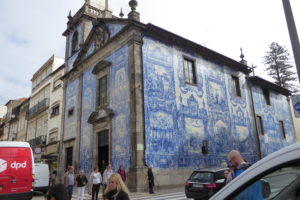
We arrived by Metro from Povoa de Varzim to Bolhao (one after Trindade); as you emerge onto the busy Rua de Santa Catarina you are faced with the extraordinary azulejo-bedecked Capela das Almas. This street is absurdly stylish and romantic, with trim boutiques, striped stone footpaths and animated crowds. It’s home to Porto’s most ornate tearoom, the art nouveau Café Majestic, and at the Southern end (downhill) is the eclectic Praça da Batalha, framed by Nasoni’s baroque Igreja de Santo Ildefonso with its twin bell towers, and the lavishly romantic Teatro Nacional São João , built in the style of Paris’ Palais Garnier.
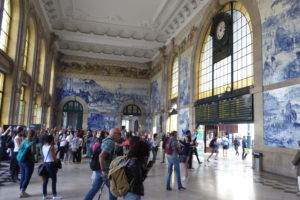
Wend your way through the steep mediaeval streets back one block and West (left) to Estação de São Bento: São Bento Train Station, one of the world’s most beautiful train stations in beaux arts style. Completed in 1903, it has a mansard roof, but the dramatic azulejo panels of historical scenes in the front hall are the real attraction. Designed by Jorge Colaço in 1930, some 20,000 tiles depict historic battles (including Henry the Navigator’s conquest of Ceuta), as well as the history of transport.
Step out of the front entrance to the station, turn left (West) on Avenue de Afonso Henriques, and follow the crowds to the hulking, hilltop fortress of the Sé Cathedral. Founded in the 12th century, it was largely rebuilt a century later and then extensively altered during the 18th century. However, you can still make out the church’s Romanesque origins in the barrel-vaulted nave. Inside, a rose window and a 14th-century Gothic cloister also remain from its early days. History lends the cathedral gravitas – this is where Dom João I married his beloved Philippa of Lancaster in 1387, and where Prince Henry the Navigator was baptised in 1394, the fortune of far-flung lands but a distant dream. While we were there, on a Saturday morning, visitors were unwitting voyeurs to a marriage ceremony, complete with a stunning soprano singing Ave Maria and Panus Angelicus. The square at the Western façade offers stunning views across terracotta rooftops and down to the curving river sparkling below.
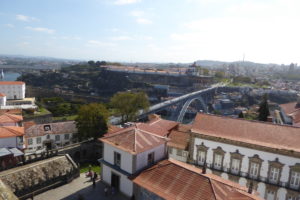
Ponte de Dom Luis I
Wander at this level for the upper metro line and walkway, or head downhill through a tangle of mediaeval alleys and stairways to the monumental, double-decker Ponte de Dom Luís I bridge, completed in 1886 by a student of Gustave Eiffel. The lower deck bears regular traffic, as well as narrow walkways for those on foot. The views of the river and old town are stunning, as are the daredevils who leap from the lower level. The bridge’s construction was significant, as the area’s foot traffic once navigated a bridge made from old port boats lashed together. To make matters worse, the river was wild back then, with no upstream dams. When Napoleon invaded in 1809, scores were crushed and drowned in the rushing river as a panicked stampede proved too much for the makeshift bridge.
Cross the bridge to the Jardim do Morro, which can also be reached by cable car. Shaded by palms, these gardens are all about the view. From here, Porto looks stunning, with the pastel-hued houses of Ribeira on the opposite side of the Douro and the snaking river below.
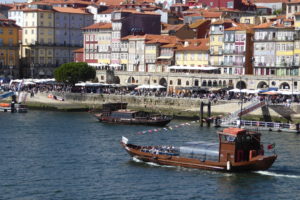
Follow the path along the edge of the garden and steeply downhill, doubling back to pass under the bridge, then turn left (West) onto the riverside promenade to enjoy picture-postcard views of the barcos rabelos (flat-bottomed boats) once used to transport port from the Douro. You are now among the port-wine lodges in Vila Nova de Gaia.
Return across the river for the Cais da Ribeira, the riverfront promenade where buskers serenade crowds, and chefs fire up grills in the hole-in-the-wall fish restaurants and tascas (taverns) in the old arcades. Continue West to the Praça da Ribeira, where the narrow streets open out onto a plaza framed by austerely grand, tiled town houses overlooking a picturesque stretch of the river.
A little further West and a couple of streets back from the river, Igreja de São Francisco looks from the outside to be an austerely Gothic church, but inside it hides one of Portugal’s most dazzling displays of baroque finery. Hardly a centimetre escapes unsmothered, as otherworldly cherubs and sober monks are drowned by nearly 100kg of gold leaf. If you see only one church in Porto, make it this one. High on your list should be the nave, interwoven with vines and curlicues, dripping with cherubs and shot through with gold leaf. Peel back the layers to find standouts such as the Manueline-style Chapel of St John the Baptist, the 13th-century statue of St Francis of Assisi and the 18th-century Tree of Jesse, a polychrome marvel of an altarpiece. The church museum harbours a fine, well-edited collection of sacred art. In the eerily atmospheric catacombs, the great and the good of Porto were once buried. Look out for sculptural works by Italian master Nicolau Nasoni and prolific Portuguese sculptor António Teixeira Lopes.
Just North of Praça Ribeira is the Palácio da Bolsa. This splendid neoclassical monument (built from 1842 to 1910) honours Porto’s past and present money merchants. Just past the entrance is the glass-domed Pátio das Nações (Hall of Nations), where the exchange once operated. But this pales in comparison with rooms deeper inside; to visit these, join one of the half-hour guided tours, which set off every 30 minutes. The highlight is a stupendous ballroom known as the Salão Árabe (Arabian Hall), with stucco walls that have been teased into complex Moorish designs, then gilded with some 18kg of gold.
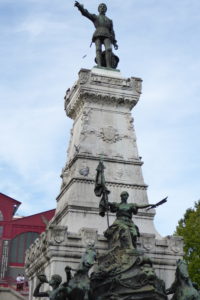
The green square in front of the latter two buildings is the Jardim do Infante Dom Henrique, named after the centrepiece statue. Lifted high on a pedestal, the monument depicts Prince Henry the Navigator (1394–1460) – a catalyst in the Age of Discoveries and pioneer of the caravel (a small, fast ship), who braved the battering Atlantic in search of colonies for Portugal’s collection. The gardens are flanked on their Northern edge by the late-19th-century market hall Mercado Ferreira Borges, now a food hall and entertainment venue.
Continue North to the viewpoint of Miradouro da Vitória , from where Porto is reduced to postcard format, a mosaic of terracotta rooftops that tumble down to the Douro. It’s a highly atmospheric spot at dusk, when landmarks such as the Ponte Dom Luís I bridge are illuminated and the lights on Vila Nova de Gaia’s wine lodges flick on one by one.
Still heading North, follow Rua de São Bento da Vitória. With its cobblestones polished smooth by centuries of shoe leather, and pretty tiled houses with little wrought-iron balconies and window boxes brimming with pot plants, this narrow, gently curving street was the beating heart of Jewish Porto in late mediaeval times. Keep your eyes peeled for telltale sights of Jewish heritage, such as bronze Hamsa (protective hand) door knockers. The Mosteiro de São Bento da Vitória was built on former Jewish ground in the 16th century by Benedictine monks. Note the sign in front of this former monastery apologising for the expulsion of the Jews in 1496 under the Portuguese Inquisition and the iron fist of King Manuel I. Now classified a National Monument, it includes a beautiful granite cloister and hosts musical performances.
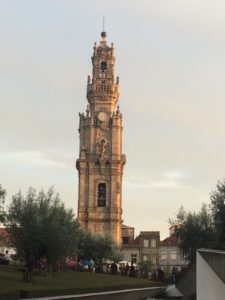
At the top of the Rua de São Bento da Vitória to the right is the Torre dos Clérigos, that you’ve probably noticed as part of any rooftop view of the city. This 76m-high tower was designed by Italian-born baroque master Nicolau Nasoni in the mid-1700s. Climb its 225-step spiral staircase for phenomenal views over Porto’s tiled rooftops, spires and the curve of the Douro to the port-wine lodges in Gaia. It also harbours an exhibition that chronicles the history of the tower’s architects and residents.
Northwest across the square is the Igreja das Carmelitas. Look closely to see that this is a church in its own right, snuggled as close as it is to the Igreja do Carmo. The twin churches are separated only by a 1m-wide house, once the dividing line between the monks of Carmo and the Carmelite nuns. Dating to the 17th century, its modest classical facade belies its lavishly gilded nave.
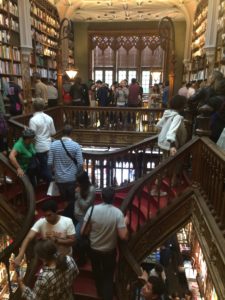
Off the opposite corner of the square (East) is the Livraria Lello, obvious initially by the long queue for entry. Ostensibly a bookshop, but even if you’re not after books, in a number of languages, don’t miss this exquisite 1906 neo-Gothic confection, with its lavishly carved plaster resembling wood and a stained-glass skylight. Its ‘byline’ is ‘A magical place’, and it inspired JK Rowling, working on her Harry Potter books while teaching English here in the early 1990s, to include a version of its intricately wrought, curiously twisting staircase. The €5 entry is redeemable if you buy a book.
Continue Southeast for Avenida dos Aliados, which recalls grand Parisian imitators such as Buenos Aires and Budapest. It is lined with bulging, beaux arts façades and headed by the stately câmara municipal (municipal council) building. The avenue’s central plaza was restored a few years back and often hosts pop-up book, comic and art festivals and exhibitions.
By now possibly a metro ride West from Aliados station, change at Trindade for Casa da Música. At once minimalist, iconic and daringly imaginative, the Casa da Música is the beating heart of Porto’s cultural scene and the home of the Porto National Orchestra. Dutch architect Rem Koolhaas rocked the musical world with this crystalline creation – the jewel in the city’s European Capital of Culture 2001 crown. The wonky cuboid conceals a shoebox-style concert hall lauded for some of the world’s best acoustics. If your curiosity has been piqued, join one of the daily guided tours.
